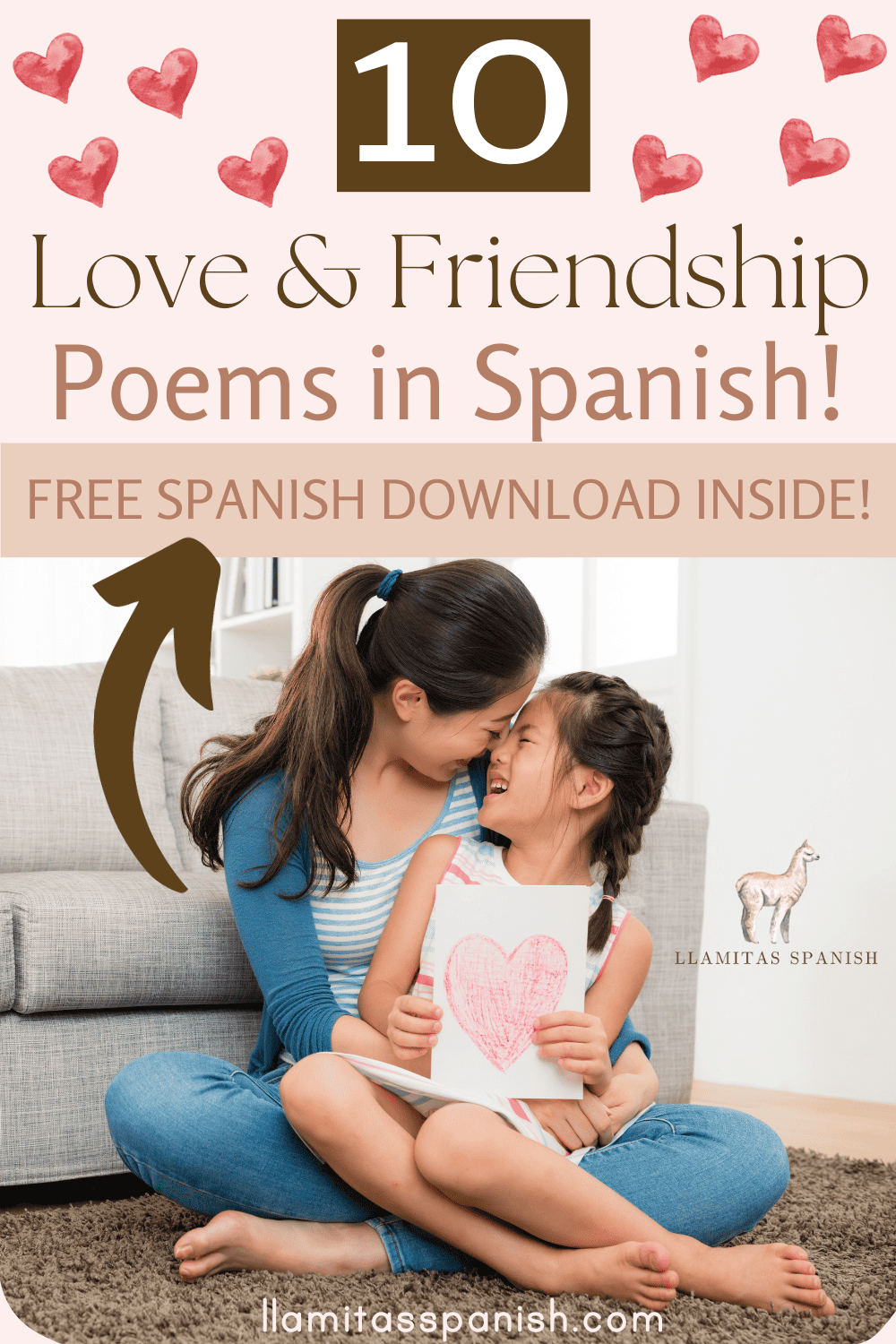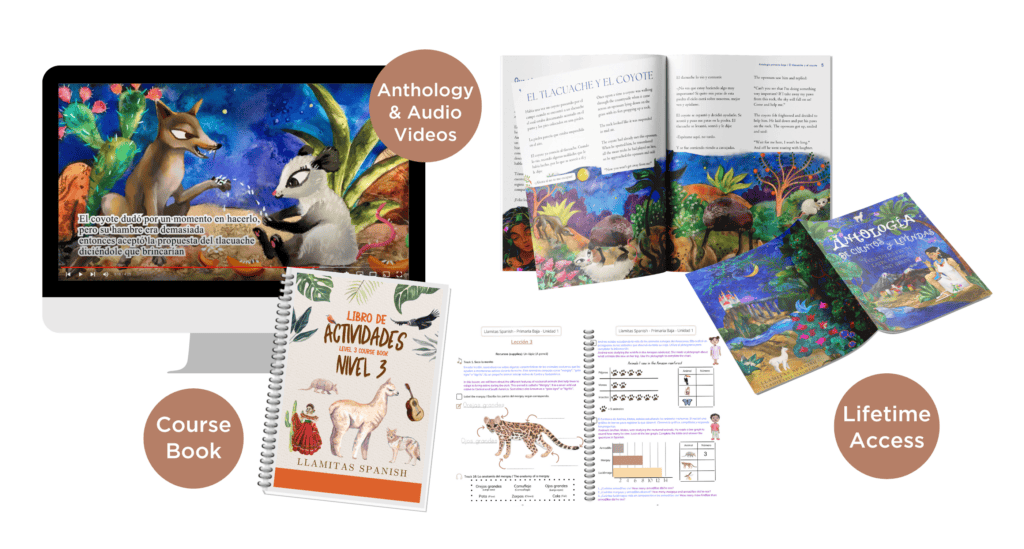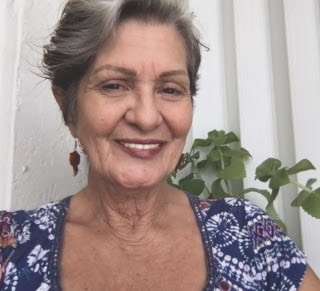In this post: A selection of Spanish love poems to celebrate romantic love and friendship that your family can enjoy this Valentine’s Day.
In Hispanic/Latino culture, el Día de San Valentín, or St. Valentine’s Day, is a holiday that celebrates love and friendship.
One of the best ways to express these sentiments is through poetry!
We are sharing Poemas de amor y amistad (Spanish love and friendship poems) that you can enjoy with your kids as part of becoming fluently and culturally bilingual.
Related post: Best Spanish Poetry Books for Kids

Most families in Spain and across Latin America, as well as Latino/Hispanic families living as immigrants in the U.S. and other countries, typically celebrate St. Valentine’s Day as a day to honor not only romantic partners, but also friends, family, and loved ones near and far.
We celebrate love in all forms, from love of nature, to love of family, love for our friends, our pets, and our world at large.
Because Spanish is such a romantic language, it’s only natural that the language lends itself to a wide variety of ways to express the different forms of love through poetry!
Table of Contents
Llamitas Spanish Valentine’s Day Unit
Many families are providing comprehensive Spanish education for their children in the comfort of their homes by taking advantage of our comprehensive Llamitas Spanish® Curriculum.
Llamitas Spanish® introduces children to Hispanic/Latino culture through a variety of activities, and these include children’s songs, lullabies, and poems.
Our curriculum provides the basic educational tools you’ll need to get your child to enjoy learning Spanish effortlessly.
But we don’t stop there.
You can amplify your child’s exposure to the Spanish language by adding holiday and seasonal units to the curriculum that provide thematic activities for the holidays.

Many of our Spanish Seasonal Units include poems, songs, and nursery rhymes as a way to enhance language fluency.
Why Read Spanish Poetry with your Kids?
Poetry, particularly if it rhymes or is set to a catchy tune, is a great way to enhance a child’s pronunciation skills.
It also improves their ability to memorize phrases while learning the suggested meaning of things and simple concepts such as metaphors and similes, even if they’re actually too young to identify these concepts.
It’s easy and fun to memorize poems, and this can enhance your kids’ learning experience in a number of ways, such as stimulating their creativity, improving memory and expanding vocabulary.
It also helps them experience the different ways in which people express their emotions, such as by writing love poems.
Finally, poetry is also an excellent way to introduce children to literature and famous authors. After reading some of these beautiful love poems, maybe you and your child can sit down and write a Spanish love poem yourselves.
Who knows? Maybe your blooming linguist is also a poet in the making!
FREE Spanish Love & Friendship Poem Download
For a short and sweet Valentine’s Day note to share with friends and teachers, be sure to check out the Freebie Library to download it today!

We have selected 10 of our favorite Spanish love poems, addressing different forms of love and friendship, along with their translations.
These poems are fun to recite and easy to learn and celebrate all different types of love and friendship.
Authentic ‘Poemas de Amor y Amistad’
Cultivo una rosa blanca (José Martí Cuba)
Cultivo una rosa blanca (I cultivate a white rose)
En junio como en enero (In June as in January)
Para el amigo sincero (For the sincere friend)
Que me da su mano franca (Who gives me his hand frankly.)
Y para el cruel que me arranca (And for the cruel one who rips out)
El corazón con que vivo (The heart I live with,)
Cardo ni oruga cultivo (I cultivate neither nettles nor thorns,)
Cultivo una rosa blanca. (I cultivate a white rose.)
More on poet José Martí’s life here.
Amo, Amas (Rubén Darío, Nicaragua)
Amar, amar, amar, amar siempre, con todo (To love, to love, to love, always to love, with your whole)
el ser y con la tierra y con el cielo, (Being and with the earth and the sky)
con lo claro del sol y lo oscuro del lodo; (With the brightness of the sun and the darkness of the mud;)
amar por toda ciencia y amar por todo anhelo. (To love for all knowledge and to love for all longing.)
Y cuando la montaña de la vida (And when the mountain of life)
nos sea dura y larga y alta y llena de abismos, (Is hard and long and high, and full of abysses,)
amar la inmensidad que es de amor encendida (to love the vastness that is made of burning love)
¡y arder en la fusión de nuestros pechos mismos! (and burn in the fusion of our very hearts!)
More on poet Rubén Darío’s life here.
La plaza tiene una torre (Antonio Machado, Spain)
La plaza tiene una torre, (The plaza has a tower,)
la torre tiene un balcón, (The tower has a balcony,)
el balcón tiene una dama, (The balcony has a lady,)
la dama una blanca flor. (The lady has a white flower.)
Ha pasado un caballero (A gentleman has passed by)
-¡quién sabe por qué pasó!- (-Who knows why he passed the tower-)
y se ha llevado la plaza, (And he has taken the plaza,)
con su torre y su balcón, (with its tower and its balcony,)
con su balcón y su dama, (with its balcony and its lady,)
su dama y su blanca flor. (its lady and her white flower.)
More on poet Antonio Machado’s life here.
Abril (Juan Ramón Jiménez, Spain)
El chamariz en el chopo. (The songbird in the poplar.)
-¿Y qué más? (-And what else?)
El chopo en el cielo azul. (The poplar in the blue sky.)
– ¿Y qué más? (-And what else?)
El cielo azul en el agua. (The blue sky on the water.)
– ¿Y qué más? (-And what else?)
El agua en la hojita nueva. (The water in the new leaf.)
– ¿Y qué más? (-And what else?)
La hojita nueva en la rosa. (The new leaf on the rose.)
– ¿Y qué más? (-And what else?)
La rosa en mi corazón. (The rose in my heart.)
– ¿Y qué más? (-And what else?)
¡Mi corazón en el tuyo! (My heart in yours!)
More on poet Juan Ramón Jiménez’s life here.
Mariposa del aire (Federico García Lorca ~ Spain)
Mariposa del aire, (Butterfly in the air)
qué hermosa eres. (How beautiful you are.)
Mariposa del aire, (Butterfly in the air)
dorada y verde. (gilded and green.)
Luz del candil, (Light of the lamp,)
mariposa del aire, (butterfly in the air,)
¡quédate ahí, ahí, ahí! (stay there, there, there! …)
No te quieres parar, (You don’t want to stop,)
pararte no quieres. (to stop you don’t want.)
Mariposa del aire (Butterfly in the air,)
dorada y verde. (gilded and green.)
Luz de candil, (Light of the lamp,)
mariposa del aire, (butterfly in the air,)
¡quédate ahí, ahí, ahí!. (stay there, there, there! …)
¡Quédate ahí! (Stay there!)
Mariposa, ¿estás ahí? (Butterfly, are you there?)
More on poet Federico García Lorca’s life here.
Dame la mano (Gabriela Mistral, Chile)
Dame la mano y danzaremos; (Give me your hand and we shall dance;)
dame la mano y me amarás. (give me your hand and you shall love me.)
Como una sola flor seremos, (Like one flower we shall be,)
como una flor, y nada más… (like a flower, and nothing more . . .)
El mismo verso cantaremos, (We shall sing the same verse,)
al mismo paso bailarás. (you shall dance at the same pace.)
Como una espiga ondularemos, (Like a spike we shall undulate)
como una espiga, y nada más. (like a spike, and nothing more.)
Te llamas Rosa y yo Esperanza; (Your name is Rose and mine is Hope,)
pero tu nombre olvidarás, (but you shall forget your name,)
porque seremos una danza (because we shall become a dance)
en la colina y nada más… (atop the hill and nothing more . . .)
More about poet Gabriela Mistral’s life here.
Parejas (Gloria Fuertes, Spain)
Cada abeja con su pareja. (Every bee with its pair )
Cada pato con su pata. (Every duck with its duck)
Cada loco con su tema. (Every fool with his song)
Cada tomo con su tapa. (Every book with its cover)
Cada tipo con su tipa. (Every guy with his gal.)
Cada pito con su flauta. (Every whistle with its flute.)
Cada foco con su foca. (Every lens with its seal.)
Cada plato con su taza. (Every plate with its cup.)
Cada río con su ría. (Every river with its stream.)
Cada gato con su gata. (Every kit with its cat.)
Cada lluvia con su nube. (Every rain with its cloud.)
Cada nube con su agua. (Every cloud with its water.)
Cada niño con su niña. (Every boy with his girl.)
Cada piñón con su piña. (Every cone with its pineapple.)
Cada noche con su alba. (Every night with its dawn.)
More about Gloria Fuerte’s life here.
Sobre el cuerpo de la luna (Miguel Hernández, Spain)
Sobre el cuerpo de la luna (On the body of the moon)
nadie pone su calor. (No one deposts their heat)
Frente a frente sol y luna (Face to face the sun and moon)
entre la luna y el sol (Face to face the sun and moon)
que se buscan y no se hallan (Seeking and not finding one another)
tú y yo. (You and I.)
Pero por fin se hallarán (But they’ll find each other some day)
nos hallaremos, amor, (We will find one another, my love)
y el mundo será redondo (And the world with be round)
hacia nuestro corazón. (Toward our heart.)
More about poet Miguel Hernández here.
El sapo verde (Carmen Gil, Spain)
Ese sapo verde (The green toad )
se esconde y se pierde; (hides so you’ll miss him;)
así no lo besa
ninguna princesa. (So that no princess will kiss him)
Porque con un beso (Because with a kiss)
él se hará princeso
o príncipe guapo; (He’ll turn into a handsome prince;)
¡y quiere ser sapo! (and he wants to be a toad!)
No quiere reinado, (He doesn’t want a kingdom,)
ni trono dorado, (nor a golden throne,)
ni enorme castillo, (nor a giant castle,)
ni manto amarillo. (nor a yellow robe.)
Tampoco lacayos (Neither lackeys)
ni tres mil vasallos. (Nor three thousand vassals.)
Quiere ver la luna (He just wants to look at the moon)
desde la laguna. (from the lagoon)
Una madrugada (One early morning)
lo encantó alguna hada; (some fairy bewitched him;)
y así se ha quedado: (And now he remains)
sapo y encantado. (A toad and delighted.)
Disfruta de todo: (Enjoying it all:)
se mete en el lodo (playing in the mud)
saltándose, solo, (hopping alone,)
todo el protocolo. (The whole protocol.)
Y le importa un pito (And he isn’t bothered)
si no está bonito (Because he’s not pretty.)
cazar un insecto; (He’ll hunt an insect;)
¡que nadie es perfecto! (no one is perfect!)
¿Su regio dosel? (And his regal canopy?)
No se acuerda de él. (He doesn’t remember it.)
¿Su sábana roja? (His red bedsheet?)
Prefiere una hoja. (He prefers a leaf.)
¿Su yelmo y su escudo? (His helmet and shield?)
Le gusta ir desnudo. (He likes to go naked.)
¿La princesa Eliana? (And princess Eliana?)
Él ama a una rana. (He now loves a frog.)
A una rana verde (A green frog)
que salta y se pierde (who jumps and hides)
y mira la luna (and looks at the moon)
desde la laguna. (from the lagoon.)
More about poet Carmen Gil here.
Si me quieres, quiéreme entera (Dulce María Loynaz, Cuba)
Si me quieres, quiéreme entera, (If you love me, love me whole)
no por zonas de luz o sombra… (not by zones of light or shadow…)
Si me quieres, quiéreme negra (if you love me, love me black)
y blanca, y gris, verde, y rubia, (and white, and gray and green and blond,)
y morena… (and mixed…)
Quiéreme día, (love me day,)
quiéreme noche… (love me night…)
¡Y madrugada en la ventana abierta!… (and in the morning with the open window!)
Si me quieres, no me recortes: (If you love me, don’t break me in pieces:)
¡Quiéreme toda… O no me quieras! (love me whole… Or do not love me at all.)
More about poet Dulce María Loynaz here.
Llamitas Spanish Curriculum
To continue your poetic journey with your little linguist, explore our Llamitas Spanish Curriculum levels where you will find academic, beautiful and culturally authentic materials for your little linguists.
Poetry is woven into every level and is rooted in the Hispanic culture. In levels 1 and 2 students learn authentic nursery rhymes, songs, and poetical recitations.
Then in level 3 they dive into complete Spanish poems and Hispanic folktale literature!


